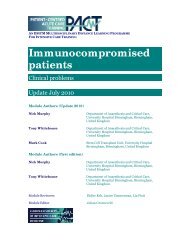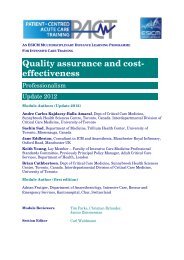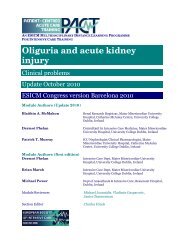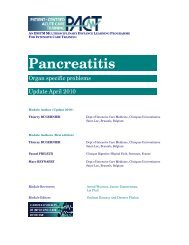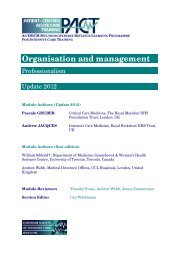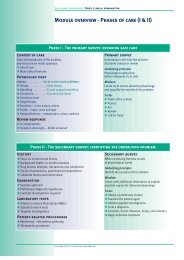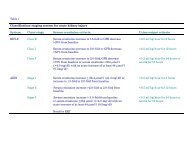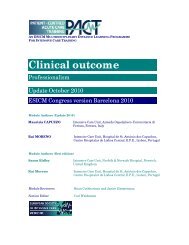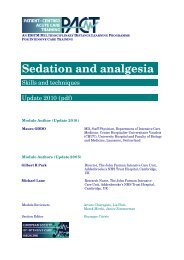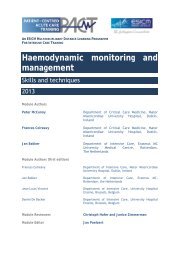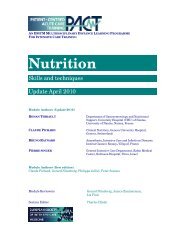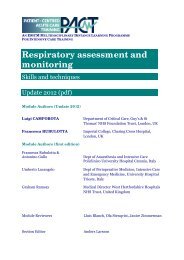Burns injury - PACT - ESICM
Burns injury - PACT - ESICM
Burns injury - PACT - ESICM
Create successful ePaper yourself
Turn your PDF publications into a flip-book with our unique Google optimized e-Paper software.
ut this risk increases over time. Also, the patients may have ongoing septic<br />
problems, where the treatment is surgery and wound revision.<br />
Added to these points are other specific needs of these patients.<br />
<br />
<br />
Difficulties in maintaining body temperature.<br />
Specific needs for ventilator support as, in the larger injuries, there is a risk<br />
for early ARDS and the possible effects of inhalation injuries.<br />
With these listed problems, good outcome crucially depends on good patient<br />
monitoring. Therefore most units use:<br />
Pulse oximetry/capnography; invasive blood pressure measurements, central venous<br />
pressure monitoring, and cardiac output/systemic vascular resistance assessment.<br />
Repeated measurements of haemoglobin, (or haematocrit) and blood gas assessment<br />
including Na/K and glucose are common during surgery in the most severely injured<br />
patients.<br />
In cases with concomitant respiratory compromise, conventional lung mechanics<br />
parameters (airway pressures; dynamic and static compliance) provided by the<br />
ventilator are also used for surveying the status of the patient.<br />
Perioperative considerations<br />
Early fluid treatment during surgery<br />
In cases where surgery is performed within 24 hrs post burn, the regular strategy for<br />
fluid treatment is followed (Parkland formulae). This strategy is not altered as<br />
surgery is performed. Many units provide blood transfusion according to losses and<br />
with no further addition. At times evaporative losses may be larger and these should<br />
then be included also in the calculation of fluid losses. It is important to note that<br />
after the start of surgery, the diuresis often decreases due to the added stress<br />
response of surgery and attention should be directed to the fluid balance. When the<br />
necrotic skin is removed, diuresis may increase.<br />
Significant intraoperative fluid loss is common in this group of patients.<br />
Haemorrhage may be complicated by coagulopathy, requiring transfusion of blood<br />
and blood products. Care is taken to limit the potential for hypothermia.<br />
Perioperative blood loss and severe sepsis<br />
The dominant risk and difficulty with burn surgery has been the blood loss<br />
encountered in these events, when at the same time it is difficult to assess<br />
quantitatively how large this loss is. Furthermore intraoperative bacteraemia and<br />
sepsis may contribute to the hypotension.<br />
A common rule is to pay extra attention to the blood pressure recordings in addition<br />
to the assessment of the wounds. Decreasing blood pressure is a sign of a negative<br />
transfusion balance. Other measures that can help in this assessment are pulse<br />
pressure variations (with respiration) and effects on the plethysmographic part of the<br />
oximetry signal. Blood loss may vary substantially between patients and burn excision<br />
in the face, neck, torso and hands constitutes the major problem. It underlines the<br />
need to follow the circulatory surveillance parameters.<br />
38




